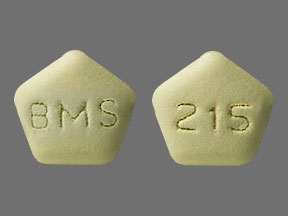Generic Daklinza Availability
Last updated on Sep 10, 2025.
Daklinza is a brand name of daclatasvir, approved by the FDA in the following formulation(s):
DAKLINZA (daclatasvir dihydrochloride - tablet;oral)
-
Manufacturer: BRISTOL-MYERS SQUIBB
Approval date: July 24, 2015
Strength(s): EQ 30MG BASE (discontinued) [RLD], EQ 60MG BASE (discontinued) [RLD] -
Manufacturer: BRISTOL-MYERS SQUIBB
Approval date: April 13, 2016
Strength(s): EQ 90MG BASE (discontinued) [RLD]
All of the above formulations have been discontinued.
Note: Fraudulent online pharmacies may attempt to sell an illegal generic version of Daklinza. These medications may be counterfeit and potentially unsafe. If you purchase medications online, be sure you are buying from a reputable and valid online pharmacy. Ask your health care provider for advice if you are unsure about the online purchase of any medication.
See also: Generic Drug FAQ.
Related patents
Patents are granted by the U.S. Patent and Trademark Office at any time during a drug's development and may include a wide range of claims.
-
Hepatitis C virus inhibitors
Patent 8,329,159
Issued: December 11, 2012
Inventor(s): Belema; Makonen et al.
Assignee(s): Bristol-Myers Squibb Company (Princeton, NJ)The present disclosure relates to compounds, compositions and methods for the treatment of hepatitis C virus (HCV) infection. Also disclosed are pharmaceutical compositions containing such compounds and methods for using these compounds in the treatment of HCV infection.
Patent expiration dates:
- July 24, 2029✓
- July 24, 2029
-
Crystalline form of methyl ((1S)-1-((25)-2-(5-(4'-(2-((25)-1((2S)-2-((methoxycarbonyl)amino)-3-methylbutanoyl)-2-pyrrolidinyl)-1H-imidazol-2-yl)-1-pyrrolidinyl)carbonyl)-2-methylpropyl)carbamate dihydrochloride salt
Patent 8,629,171
Issued: January 14, 2014
Inventor(s): Kim Soojin & Gao Qi & Yang Fukang
Assignee(s): Bristol-Myers Squibb CompanyThe present disclosure generally relates to a crystalline form of methyl ((1S)-1-(((2S)-2-(5-(4′-(2-((2S)-1-((2S)-2-((methoxycarbonyl)amino)-3-methylbutanoyl)-2-pyrrolidinyl)-1H-imidazol-5-yl)-4-biphenylyl)-1H-imidazol-2-yl)-1-pyrrolidinyl)carbonyl)-2-methylpropyl)carbamate dihydrochloride salt. The present disclosure also generally relates to a pharmaceutical composition comprising a crystalline form, as well of methods of using a crystalline form in the treatment of Hepatitis C and methods for obtaining such crystalline form.
Patent expiration dates:
- June 13, 2031✓✓✓
- June 13, 2031
-
Hepatitis C virus inhibitors
Patent 8,642,025
Issued: February 4, 2014
Inventor(s): Bachand Carol & Belema Makonen & Deon Daniel H. & Good Andrew C. & Goodrich Jason & James Clint A. & Lavoie Rico & Lopez Omar D. & Martel Alain & Meanwell Nicholas A. & Nguyen Van N. & Romine Jeffrey Lee & Ruediger Edward H. & Snyder Lawrence B. & St. Laurent Denis R. & Yang Fukang & La
Assignee(s): Bristol-Myers Squibb CompanyThe present disclosure relates to compounds, compositions and methods for the treatment of hepatitis C virus (HCV) infection. Also disclosed are pharmaceutical compositions containing such compounds and methods for using these compounds in the treatment of HCV infection.
Patent expiration dates:
- August 11, 2027✓✓✓
- August 11, 2027✓✓✓
- August 11, 2027
-
Hepatitis C virus inhibitors
Patent 8,900,566
Issued: December 2, 2014
Inventor(s): Belema Makonen & Nguyen Van N.
Assignee(s): Bristol-Myers Squibb CompanyThe present disclosure relates to compounds, compositions and methods for the treatment of hepatitis C virus (HCV) infection. Also disclosed are pharmaceutical compositions containing such compounds and methods for using these compounds in the treatment of HCV infection.
Patent expiration dates:
- August 8, 2027✓
- August 8, 2027✓
- August 8, 2027
-
Hepatitis C virus inhibitors
Patent 9,421,192
Issued: August 23, 2016
Inventor(s): Belema Makonen & Nguyen Van N.
Assignee(s): Bristol-Myers Squibb CompanyThe present disclosure relates to compounds, compositions and methods for the treatment of hepatitis C virus (HCV) infection. Also disclosed are pharmaceutical compositions containing such compounds and methods for using these compounds in the treatment of HCV infection.
Patent expiration dates:
- August 8, 2027✓✓
- August 8, 2027✓✓
- August 8, 2027
More about Daklinza (daclatasvir)
- Daklinza consumer information
- Check interactions
- Compare alternatives
- Reviews (10)
- Drug images
- Side effects
- Dosage information
- During pregnancy
- FDA approval history
- Drug class: NS5A inhibitors
- Breastfeeding
Related treatment guides
Related/similar drugs
Glossary
| Term | Definition |
|---|---|
| Drug Patent | A drug patent is assigned by the U.S. Patent and Trademark Office and assigns exclusive legal right to the patent holder to protect the proprietary chemical formulation. The patent assigns exclusive legal right to the inventor or patent holder, and may include entities such as the drug brand name, trademark, product dosage form, ingredient formulation, or manufacturing process A patent usually expires 20 years from the date of filing, but can be variable based on many factors, including development of new formulations of the original chemical, and patent infringement litigation. |
| Drug Exclusivity | Exclusivity is the sole marketing rights granted by the FDA to a manufacturer upon the approval of a drug and may run simultaneously with a patent. Exclusivity periods can run from 180 days to seven years depending upon the circumstance of the exclusivity grant. |
| RLD | A Reference Listed Drug (RLD) is an approved drug product to which new generic versions are compared to show that they are bioequivalent. A drug company seeking approval to market a generic equivalent must refer to the Reference Listed Drug in its Abbreviated New Drug Application (ANDA). By designating a single reference listed drug as the standard to which all generic versions must be shown to be bioequivalent, FDA hopes to avoid possible significant variations among generic drugs and their brand name counterpart. |
Further information
Always consult your healthcare provider to ensure the information displayed on this page applies to your personal circumstances.

